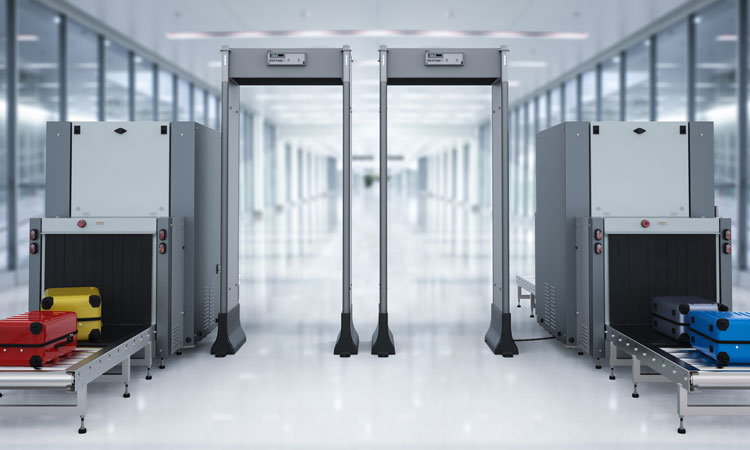Smart security
- Like
- Digg
- Del
- Tumblr
- VKontakte
- Buffer
- Love This
- Odnoklassniki
- Meneame
- Blogger
- Amazon
- Yahoo Mail
- Gmail
- AOL
- Newsvine
- HackerNews
- Evernote
- MySpace
- Mail.ru
- Viadeo
- Line
- Comments
- Yummly
- SMS
- Viber
- Telegram
- Subscribe
- Skype
- Facebook Messenger
- Kakao
- LiveJournal
- Yammer
- Edgar
- Fintel
- Mix
- Instapaper
- Copy Link
Posted: 20 October 2021 | Billy Shallow | No comments yet
Billy Shallow, Director of Innovation and Technology at ACI World, discusses Vision 2040 and the innovation the industry has seen in security during the COVID-19 pandemic, which will continue in the future.


Earlier this year (2021), ACI World released its Smart Security Vision 2040 paper outlining a path towards transformational change within aviation security. The vision was devised by the Smart Security Management Group consisting of some of the world’s most innovative airports, government regulators, and airlines. The vision sets out ambitions to protect the whole of the airport infrastructure instead of simply detecting prohibited items within the security checkpoint. Concerns regarding landside attacks, drone disruptions, cyber-attacks, and insider threats highlight the need to start looking for those with ill intent, as well as prohibited items.
Due to the ongoing COVID-19 pandemic, which saw traffic levels decline significantly, airports have paused transformation programmes to reduce overheads in line with depleted flight numbers. However, there has been some positive news within the industry when it comes to innovation in aviation security. Several progressions and developments will be here to stay, focusing on improved security, better facilitation, and customer experience, as well as making checkpoints more operationally efficient.
Reduced handling
The roll out of computed tomography (CT) has accelerated due to the COVID-19 pandemic. Many airports including Smart Security’s London Heathrow Airport (LHR) have continued to focus on this roll out due to the security benefits, as well as the ability to reduce bag searches due to automated algorithms and reducing handling, as passengers no longer need to divest liquids and large electricals from their cabin bags. The roll out of CT machines can be supported by algorithms for automated detection of prohibited items to reduce the number of screeners, which is key during an uncertain time for the aviation industry. Amsterdam Airport Schiphol (AMS) and NCTV (the main Dutch counter-terrorism unit) have been successfully trialling and implementing algorithms, which are more accurate, or to the same standard of detection, by that of traditional screeners.
Terahertz scanners have also been trialled to reduce physical pat-downs to minimise body searches during the COVID-19 pandemic. These have been successfully used for staff screening at airports including Seattle Tacoma Airport (SEA). These scanners allow for the screener to highlight an anomaly on the body and request the item to be divested. We will continue to see this new technology being rolled out after the COVID-19 pandemic, to aid with security detection, as well as reduce physical contact and improve throughput. These scanners have been sent for the EU Civil Aviation Conference and Transportation Security Administration certification process, which will see them pass rigorous tests prior to being implemented for passenger screening.
The Vision for future security
Standoff detection is a key component of Vision 2040, which continues to be evaluated at different airports. Terahertz scanners will play a key role in this, although airports have continued to secure their landside areas with standoff detection capabilities to prevent and deter landside attacks. Such systems screen mass passengers on arrival at airports or via train stations to avoid passengers having to stop prior to the entry points to the terminal whilst being screened for threats unobtrusively. Furthermore, these systems will play a key role in reaching Vision 2040’s goal of screening passengers and baggage at walking pace throughout the airport infrastructure.
Improving passenger experience
Other initiatives that we expect to continue that stemmed from the COVID-19 pandemic include the use of virtual queueing. Whilst virtual queuing is not a security benefit, it meets the needs of two other elements of the smart security strategy – operational efficiency and customer experience. Passengers can join a slot in the queue virtually and breeze through the checkpoint once their allocated wait is over. The secondary benefit for airport operators is the optimisation of security resources and lanes by using dynamic forecasting as opposed to static forecasts.
The security checkpoint has long been a place to foster germs and bacteria due to the frequent high touchpoints of the process. To alleviate this concern during the times of the COVID-19 pandemic and moving forward, airports are increasingly focusing on hygiene within this area. Vision 2040 has been adapted to encompass health measures as there are likely to be new pandemics in the future. UV-C automated tray cleaning covers off safety in the checkpoints. Many airports, including London Gatwick Airport (LGW), are implementing these solutions to improve hygiene and provide peace of mind for passengers during travel.
Cyber-attacks are highlighted in Vision 2040 with mitigation measures required to reduce these sophisticated attacks. Whilst the threat of unlawful interference remains low on the International Civil Aviation Organization’s risk matrix for aviation security, there is significant opportunity for attackers to bring airports to a standstill with the likes of ransomware increasing significantly. Airports must take a holistic approach to aviation security which includes implementing robust cyber‑security programmes to combat these threats. ACI World has noted an increase in attempted cyber‑attacks against airports. This threat will continue to develop over the next 20 years, as the use of technology and digital transformation continues to be accelerated.
Whilst we may all feel like we have lost over a year of travel due to COVID-19, airports are continuing to adapt and focus on improving security at airports, coupled with greater levels of efficiency during challenging financial times, as well as improving the customer experience to reassure passengers that flying is safe. The year 2020 was not a dead duck for aviation security, and small stepping-stones to innovate at airports bring us one step closer to achieving the vision of seamless walk‑through security.


Issue
Related topics
COVID-19, Cyber-security, New technologies, Passenger experience and seamless travel, Security, Terminal operations
Related airports
Amsterdam Airport Schiphol (AMS), London Gatwick Airport (LGW), London Heathrow Airport (LHR), Seattle-Tacoma International Airport (SEA)


















